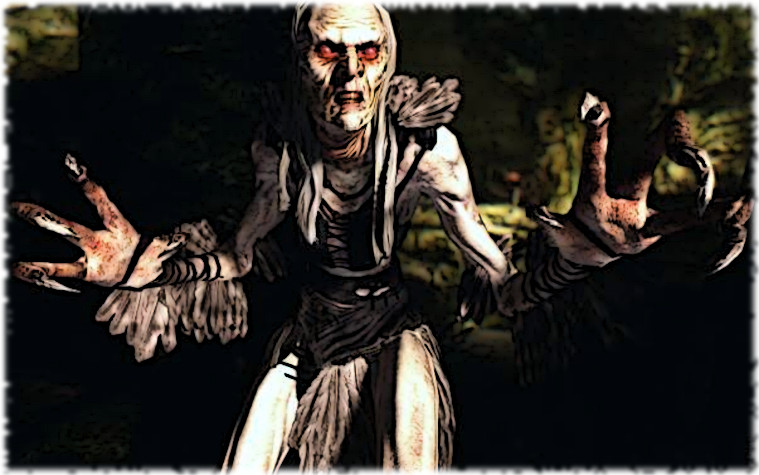Tacitus: Difference between revisions
No edit summary |
No edit summary |
||
| (5 intermediate revisions by the same user not shown) | |||
| Line 1: | Line 1: | ||
;[[Gangrel]] -SPQR- [[Rome -- medieval]] | ;[[Gangrel]] -SPQR- [[Rome -- medieval]] | ||
[[]] | [[File:Gangrel Tacitus.jpg]] | ||
<br> | <br> | ||
<br> | <br> | ||
'''Sobriquet:''' ''The Silent'' or ''The | '''Sobriquet:''' ''The Silent'', ''The Mute'' or ''The Styx'' | ||
'''Appearance:''' | '''Appearance:''' The age of Tacitus at the time of Embrace is hard to guess. Embraced as a Gangrel, Tacitus was given to a slow transformation into a beast with every frenzy he suffered. In this case, something like a bird. By the time of his death, he has lost most of his human hair and what remained was bleached white. His skin had taken on the pale and loose texture of most Aves or birds. As he aged, pale feathers and down slowly grew in across his body and he often blinked in birdlike way. In terms of clothing, he cared nothing for fashion and covered his occasional nakedness in the leftover clothes of his victims, perhaps considering them trophies or the spoils of his hunting. Most noticeable of all were the hooked birdlike yellow talons that grew at the ends of his long thin fingers. | ||
'''Behavior:''' | '''Behavior:''' Tacitus was a mute who communicated with his hands. He enjoyed inflicting all forms of pain, but preferred emotional pain most of all. His modus operandi consisted of stalking a mortal, finding out everything about them and discovering who and what they loved best. Then beginning with those things, pets or people the person loved least, he would destroy them one at a time, always leaving the remnants behind where they would be found by his chosen victim. Working his way through the loved ones of the victim, he would not stop until the chosen prey would beg for death, thus ending the cycle. Once one prey was killed he would begin the whole process all over again with someone new. This style of hunting could not serve his daily need for blood, it was a hobby and he mostly fed from beasts. Beloved by his comrades in Pupilli Nocturna, he was known for traveling outside the Aurelian walls and returning with beautiful, rare or unusual gifts for his coterie members. | ||
'''History:''' | '''History:''' On the night he died, Tacitus was over three hundred years old. This suggests that he was Embraced sometime in the 8th century. | ||
'''Rest in Peace:''' | '''Rest in Peace:''' In mid-June of 1094 A.D., Tacitus and four other members of the Pupilli Nocturna led an attack on Eadwulf of the Ventrue. Tacitus was slain and as he was over three hundred years old, his body crumbled into bones and dust. But in the near instantaneous decay of his body, a host of small black-birds were released from his eye sockets, mouth and chest cavity. | ||
Latest revision as of 14:46, 18 February 2018
- Gangrel -SPQR- Rome -- medieval

Sobriquet: The Silent, The Mute or The Styx
Appearance: The age of Tacitus at the time of Embrace is hard to guess. Embraced as a Gangrel, Tacitus was given to a slow transformation into a beast with every frenzy he suffered. In this case, something like a bird. By the time of his death, he has lost most of his human hair and what remained was bleached white. His skin had taken on the pale and loose texture of most Aves or birds. As he aged, pale feathers and down slowly grew in across his body and he often blinked in birdlike way. In terms of clothing, he cared nothing for fashion and covered his occasional nakedness in the leftover clothes of his victims, perhaps considering them trophies or the spoils of his hunting. Most noticeable of all were the hooked birdlike yellow talons that grew at the ends of his long thin fingers.
Behavior: Tacitus was a mute who communicated with his hands. He enjoyed inflicting all forms of pain, but preferred emotional pain most of all. His modus operandi consisted of stalking a mortal, finding out everything about them and discovering who and what they loved best. Then beginning with those things, pets or people the person loved least, he would destroy them one at a time, always leaving the remnants behind where they would be found by his chosen victim. Working his way through the loved ones of the victim, he would not stop until the chosen prey would beg for death, thus ending the cycle. Once one prey was killed he would begin the whole process all over again with someone new. This style of hunting could not serve his daily need for blood, it was a hobby and he mostly fed from beasts. Beloved by his comrades in Pupilli Nocturna, he was known for traveling outside the Aurelian walls and returning with beautiful, rare or unusual gifts for his coterie members.
History: On the night he died, Tacitus was over three hundred years old. This suggests that he was Embraced sometime in the 8th century.
Rest in Peace: In mid-June of 1094 A.D., Tacitus and four other members of the Pupilli Nocturna led an attack on Eadwulf of the Ventrue. Tacitus was slain and as he was over three hundred years old, his body crumbled into bones and dust. But in the near instantaneous decay of his body, a host of small black-birds were released from his eye sockets, mouth and chest cavity.